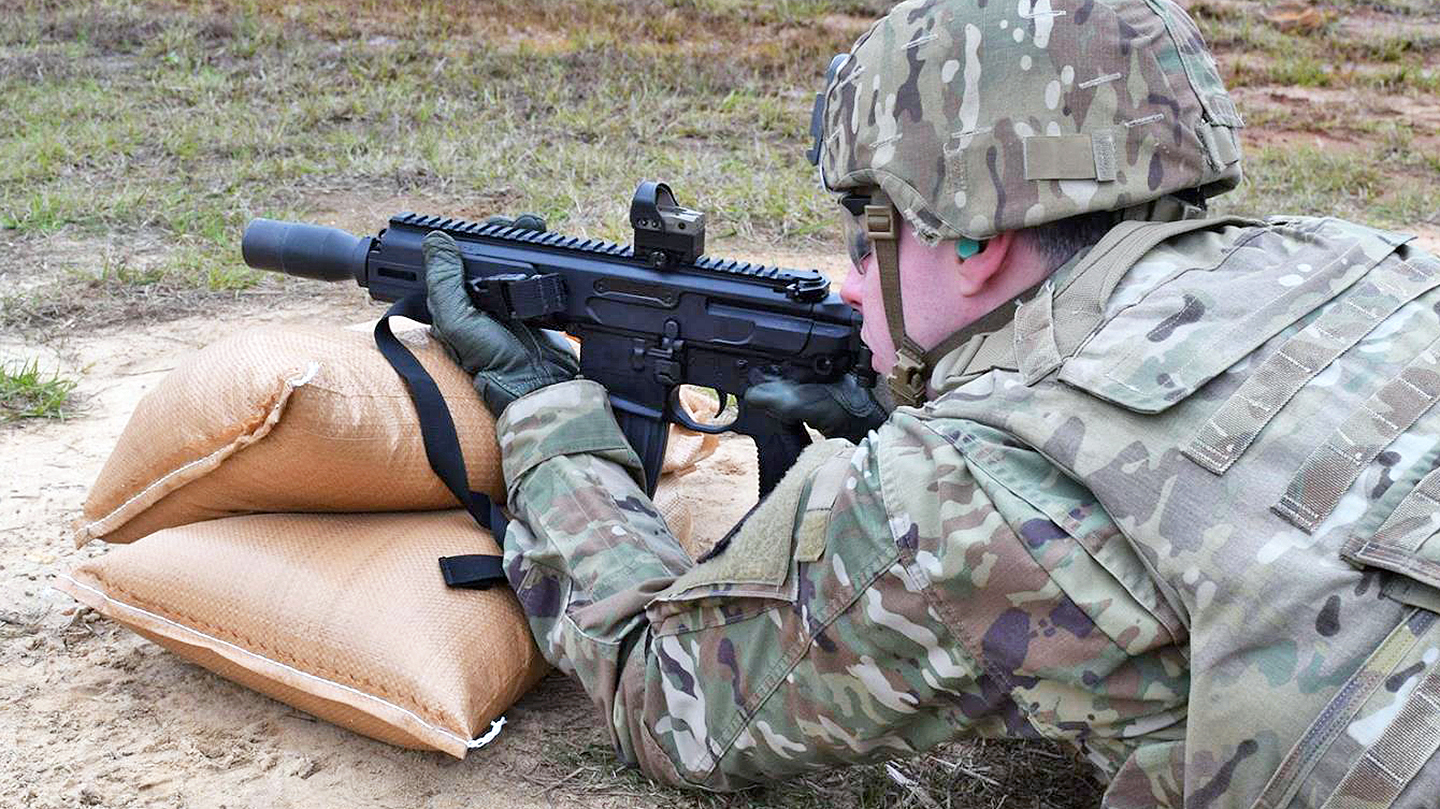U.S. special operators are finally getting ultra-compact personal defense weapons, or PDWs, chambered in .300 Blackout and standard 5.56x45mm ammunition to blast out of tight spots with a wallop similar to a full-size assault rifle.
Special Operations Command (SOCOM) on May 19 issued a notice of intent to buy Sig’s MCX Rattler short-barreled rifles as personal defense weapons, or PDWs, under a five-year sole-source contract. No contract has been awarded yet and how many of these compact weapons SOCOM will buy is unclear. “After years of continuous market research, USSOCOM HQ has concluded that Sig Sauer is the only vendor that can fulfill USSOCOM’s need for the commercial PDW requirement,” the notice, posted to the U.S. government’s primary contracting website, said.

Commercial, off-the-shelf Rattlers will come with suppressors, cleaning kits, magazines, quick barrel-change kits and training kits. The version chambered in 5.56mm uses ammunition compatible with the larger M4A1 carbine and other standard-issue infantry rifles in the U.S. inventory. SOCOM specifically wanted a rifle chambered in .300 Blackout, designed by Advanced Armament Corporation (AAC) in cooperation with Remington in the late 2000s. The cartridge was developed primarily in two flavors that can be used interchangeably in the same firearm configuration. One was to roughly match the ballistic performance of the Soviet-developed 7.62x39mm round, retaining accuracy and power when fired from a weapon with an extremely short barrel. The other includes a heavier bullet that is subsonic and ideal for suppression and close-quarters combat.

Both calibers of Rattler have a 5.5-inch barrel and receiver mounted to an AR15 style lower. At 23.5 inches with the aluminum foldable stock extended, the .300 Blackout version is half an inch longer than the rifle chambered in 5.56mm. Both weigh in right at six pounds. The rifles feature Sig’s patented M-LOK free-floating handguard, which is its own accessory attachment system, topped with a Picatinny accessory rail and an ambidextrous charging handle. SOCOM will also purchase Sig’s SL series suppressors for both versions of the rifle. All of the Rattler’s features are detailed in the video below:

The Rattler’s method of operation should also simplify and lessen the need for maintenance in the field. Sig’s MCX rifles, including the Rattler, use a physical gas piston to cycle the action rather than the AR-15/M16 series’ direct impingement system that blows propellent gas directly into the weapon’s inner workings. That system can cause residue buildup that requires regular maintenance to avoid jams.
A promotional video on Sig’s website set in a nameless bazaar in Ramadi, Iraq, shows an operator in civilian clothing pulling a Rattler from a shoulder bag, folding out the stock, and engaging a target. The scenario highlights the weapon’s concealability and relative firepower versus a submachine gun or handgun. The weapons are ideal for use in confined spaces like a vehicle or by helicopter crews and their rifle ballistics allow them to penetrate heavy body armor.

SOCOM’s search for a lightweight, compact weapon that “will allow operators to have maximum firepower in a concealable weapon” launched in 2017. The same year, SOCOM bought a small number of conversion kits from Sig to turn some of its existing M4A1 carbines into MCX Rattlers. SOCOM has been testing various complete weapon systems as PDWs continuously since then. It is not immediately clear which other weapons were tested over the five-year span or how many. The Rattler did make an appearance at the 2019 Army Expeditionary Warrior Experiments event at Fort Benning, Georgia, as seen at the top of this post.
“We have meticulously reviewed each system for technical acceptance and whether it fits the commercial definition,” SOCOM said in the notice of intent announcement. “Except for Sig Sauer, the vendors did not meet the technical requirements and/or the weapons do not meet the commercial definition.”

The search was narrowed to readily available weapons because SOCOM could not wait for prototypes to be developed and produced a year or more from now. Ultimately, “due to the programmatic requirements,” Sig is the only vendor that could provide the weapon SOCOM needs in a timely fashion, according to the announcement.
Although the official contract is still in the offing, SOCOM announcement is yet another feather in the Swiss firearm manufacturer’s cap. It recently won a huge contract to provide conventional Army troops with a new infantry rifle and squad automatic weapon, both also based on the Sig MCX. That program, formally called the Next-Generation Squad Weapon, is currently on hold while the Government Accountability Office weighs a protest by losing bidder Lone Star Future Weapons.

The Army also began replacing the M9, a version of the Beretta 92, among other handguns, with M17 and M18 Modular Handgun System pistols, customized variants of the Sig P320, in 2017.
MCX rifles are becoming an increasingly popular derivative of the AR15/M16 family of rifles, as seen in this previous War Zone piece. Special operations forces units were reportedly already using a larger version of the MCX in .300 Blackout, nicknamed the Black Mamba, as far back as 2015. That weapon, which SOCOM procured as part of its “Low Visibility Assault Weapon” program, had a nine-inch barrel. It initially was referred to as the Reduced Signature Assault Rifle Kit, which recalibrated existing rifles to firing the .300 Blackout round.
The deal for Rattlers will be far smaller in scale and dollar value than those enormous Army programs. But special operations forces certainly stand to benefit in many scenarios from the balance of compactness and potency the Rattler offers. The War Zone will be on the lookout for details on Sig’s PDW deal with SOCOM when a formal contract is eventually awarded.
Contact the author: Dan@thewarzone.com
